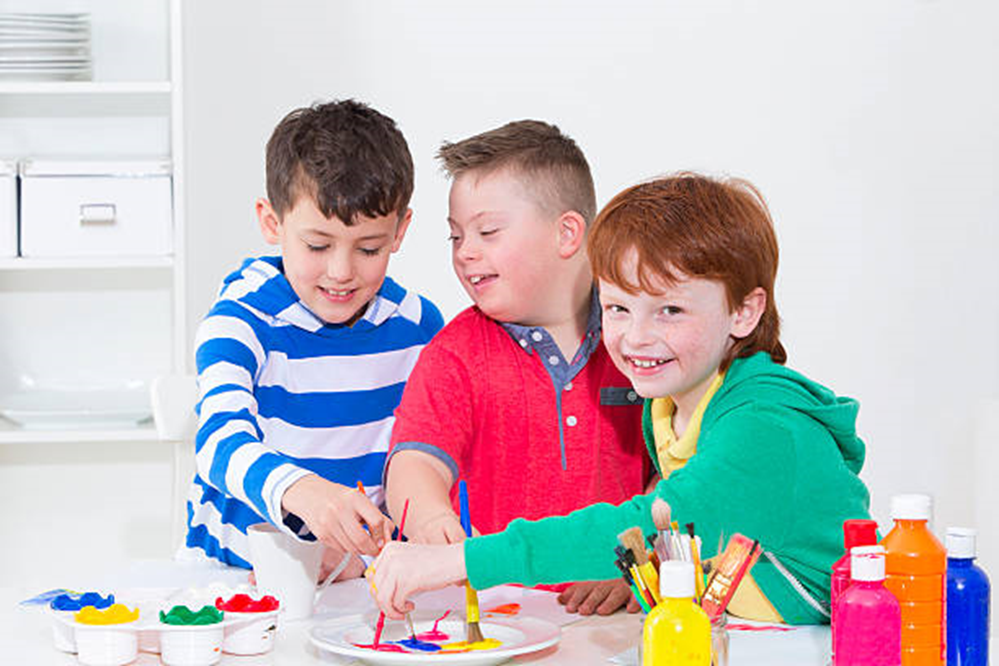10 Sensory Activities That Will Ignite Joy in Kids with Down Syndrome
Sensory Bottles: Captivating Visual Stimulation
Sensory bottles are a wonderful sensory
activity for kids with Down Syndrome. These bottles are typically filled with
various objects and liquids, creating captivating visual effects when shaken.
The mesmerizing colors, shapes, and movements provide visual stimulation,
promoting focus and engagement. Children can enjoy exploring different types of
sensory bottles, such as glitter-filled bottles, ones with floating objects, or
bottles with colorful liquids. Sensory bottles are not only visually appealing
but also have a calming effect, helping children relax and find joy in the
moment.
Sensory Tubs: Engaging Touch and Texture
Musical Activities: Stimulating Auditory Senses
Music has a powerful impact on individuals
of all abilities, and it can be particularly beneficial for children with Down
Syndrome. Engaging in musical activities stimulates their auditory senses,
fosters self-expression, and promotes cognitive development. Playing musical
instruments, singing songs, or participating in rhythm-based activities allows
children to explore different sounds, tones, and rhythms. Music therapy
sessions or joining a music class tailored for children with special needs can
be an excellent way to incorporate joyful sensory experiences into their daily
lives.
Water Play: Soothing and Sensory Exploration
Water play is a versatile and delightful
sensory activity that children with Down Syndrome can enjoy both indoors and
outdoors. It offers a multi-sensory experience by engaging the tactile, visual,
and proprioceptive senses. Splashing, pouring, and feeling the water's movement
provide a soothing and calming effect. Adding colorful floating toys, water
sprayers, or even bubbles enhances the sensory stimulation and increases the
joy factor. Water play also supports the development of motor skills,
coordination, and spatial awareness.
Art Therapy: Expressing Creativity and Emotions
Art therapy offers an excellent avenue for
children with Down Syndrome to express their creativity and emotions while
engaging their senses. Painting, drawing, sculpting, and other artistic
activities allow them to explore various materials, textures, and colors. The
process of creating art promotes fine motor skills, hand-eye coordination, and
self-expression. Art activities can be adapted to suit the child's abilities
and preferences, ensuring an enjoyable and rewarding experience that sparks joy
and fosters self-confidence.
Sensory Swings: Calming and Vestibular Stimulation
Sensory Gardens: Connecting with Nature
Sensory gardens create an immersive and
stimulating environment for children with Down Syndrome to connect with nature
and engage their senses. These specially designed gardens incorporate various
plants, flowers, and natural elements that offer visual, auditory, tactile, and
olfactory stimulation. Children can explore different textures, smell the
fragrant flowers, listen to the sounds of nature, and observe the vibrant
colors. Sensory gardens provide a serene and joyful space where kids can relax,
learn, and appreciate the beauty of the natural world.
Baking and Cooking: Sensory and Tactile Experiences
Engaging in baking and cooking activities
provides children with Down Syndrome with enjoyable sensory and tactile
experiences. The process of measuring ingredients, mixing, and kneading dough
allows them to explore different textures, temperatures, and smells. Baking
also stimulates their fine motor skills, hand-eye coordination, and sequencing
abilities. Encouraging their active participation in the kitchen promotes a
sense of accomplishment and joy when they see the results of their culinary
creations.
Dance and Movement: Body Awareness and Coordination
Dance and movement activities offer a
dynamic and joyful way for children with Down Syndrome to enhance their body
awareness and coordination. Dancing to music, practicing simple routines, or
engaging in dance therapy sessions stimulates their vestibular system, promotes
balance, and develops gross motor skills. The rhythmic movements and music
provide an uplifting sensory experience that encourages self-expression and
boosts self-esteem. Dance and movement activities can be adapted to suit
individual abilities, ensuring inclusivity and maximizing the joy of participation.
Sensory Storytime: Encouraging Imagination and Language
Skills
Sensory story time combines the joy of
storytelling with sensory experiences tailored for children with Down Syndrome.
During sensory story sessions, the narrative is enhanced by incorporating
props, tactile materials, sounds, and interactive elements. This interactive
approach engages children's imagination, supports language development, and
fosters joy in reading. Sensory story time sessions can be organized at home, in
libraries, or as part of community programs, providing a welcoming environment
where children can embrace the magic of stories and sensory exploration.
Engaging children with Down Syndrome in
sensory activities is an effective way to ignite joy, enhance their sensory
processing skills, and promote overall well-being. By providing opportunities
for visual, tactile, auditory, and movement-based experiences, we can create a
world filled with happiness and discovery for these amazing children. Remember
to tailor the activities to individual abilities, celebrate progress, and
create an inclusive environment that fosters joy, growth, and endless
possibilities.
Looking for sensory activitiesfor kids with Down Syndrome? Discover the wonders of WonderTree! Visit their website to explore our engaging and inclusive programs.





Comments
Post a Comment